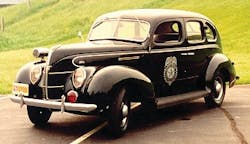It can do a mind good sometimes to pause business-as-usual and consider where we’ve been before we can realize just what we’ve accomplished, and begin to ponder what the future holds. Consider the state highway patrol officer whose job functions essentially expanded and evolved right along with the very roadways and interstates he or she patrolled. From receiving your marching orders from the service station down the road to accessing just about everything via in-car computer, the job has changed but the goal remains the same.
Here’s a brief look back at some notable moments in the history of highway patrol technology.
- 1930— The New Jersey State Police Statewide Police Teletype System provides instant communications between agencies in New Jersey and other states.
- 1941—President Roosevelt appoints a National Interregional Highway Committee to evaluate the need for a national expressway system. The January 1944 report supported a system of 33,900 miles, plus an additional 5,000 miles of auxiliary urban routes. "... so located, as to connect … principal metropolitan areas, cities, and industrial centers, to serve the National Defense, and to connect … routes of continental importance in the Dominion of Canada and the Republic of Mexico."
- 1943—Wisconsin State Patrol goes on the air, operating station WIZR on a frequency of 31.5 megahertz. It can now communicate with the patrol's mobile units and most of the municipal and county short-wave stations.
- 1949—Colorado State Patrol installs two-way radios into patrol cars. Prior to this, dispatchers would often phone local gas stations along an officer’s usual route and provide them with details of a pending service calls. Attendants at the gas station would then post a red flag alongside the highway, alerting an officer of a pending service call. The process worked surprisingly well.
- 1952—Ohio State Patrol purchases intoximeters and trains officers in their use. The intoximeter consists of a glass mouthpiece, a balloon, and three glass tubes. One tube holds a sponge that changes color to indicate alcohol in the sample. Sealed tubes preserve evidence, in case there are doubts about an arrest.
- 1954-- Stationary radar i first used for traffic speed enforcement by Virginia State patrol
- 1959—heightened Cold War tensions prompt Ohio State Highway Patrol to prepare Civil Defense Manuals for the evacuation of major target areas in the state.
- 1962—a statewide private line teletype network in Missouri permits communications between the troop headquarters, General Headquarters, and the Motor Vehicle Bureau by means of perforated tape.
- 1963—Virginia State Patrol installs a driving course for new troopers. A figure eight and "T" course permit precision driving backward and forward between traffic cones within prescribed limits.
- 1967-- New York State Police become the first New York State Agency to maintain an on-line, real time computer system with the new Computer Oriented Police System, the forerunner of the New York Statewide Police Information System
- 1968—On January 2, 1968, Missouri troopers can query the National Crime Information Center (NCIC) in Washington, D.C. via their car radios.
- 1970—handheld radios are given to New York State police, providing troopers operating away from their patrol vehicles with critically needed communications. High speed, video equipped terminals are introduced in 1974 and installed statewide in 1975.
- 1975—NJ State’s traditional black and white troop cars enter the history books with the boots and breeches and motorcycles. An all white patrol car would emerge as the principle troop vehicle.
- 1989—State Police in Virginia begin using VASCAR speed detection devices to augment radar.
- 1991—The first video recording equipment was purchased and installed in Virginia patrol vehicles
- 2000s—Smith & Wesson rifles are issued to each Iowa State trooper, and in-car computers installed into each patrol vehicle
About the Author

Sara Scullin
Sara Scullin was the Editor of Law Enforcement Technology magazine, a monthly business-to-business publication that covers technology trends and best practices for public safety managers. LET is part of SouthComm Law Enforcement Media, which also publishes Law Enforcement Product News and Officer.com. Sara had covered the law enforcement industry since March 2008.
